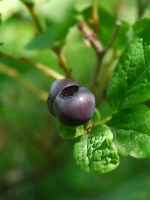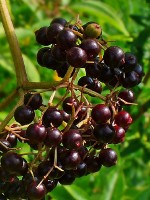Mon-Fri 9am - 5pm Mountain time
Mountain Huckleberry vs Ranch Elderberry
Vaccinium membranaceum
Sambucus canadensis Ranch
NOT AVAILABLE THIS SEASON - MIGHT RETURN
NOT AVAILABLE THIS SEASON - MIGHT RETURN
Mountain Huckleberry is a small shrub known for its tart to sweet berries. The berries range from purple-black to red-black, and can be eaten fresh or used in jams and syrups. It is a plant native to Alberta and the berries are frequently enjoyed by both people and wildlife.
In traditional Indigenous fire management practices, berry patches were burned after harvest. This would reduce the invasion of other plants allowing the Mountain Huckleberry to thrive. Its foliage has low flammability and can survive low severity fires, and even if destroyed they regrow from the roots.
Note: Mountain Huckleberry requires specific soil conditions. They need moist, well-drained, acidic soil with a pH around 5.5.
Ranch Elderberry is a vigorous and high-yielding Black Elderberry cultivar. It ripens earlier than other varieties and is smaller and more compact making berry harvest easier. The berries are well-suited for baked goods, jams, jellies, and syrups. They are high in vitamin C and reported to be beneficial for the immune system.
Black Elderberries are considered to be partially self-pollinating. So while they will still produce some berries without cross-pollination, planting with another variety will increase yields. Consider planting with Black Elderberry or Bob Gordon Elderberry.
Warning: the seeds, stems, leaves, roots, and uncooked berries are toxic to humans when eaten in quantity. Berries should be cooked to make them safe for human consumption.
Mountain Huckleberry Quick Facts
Ranch Elderberry Quick Facts
Toxicity: leaves, stems, and uncooked berries are poisonous to humans

